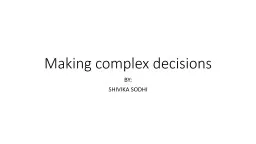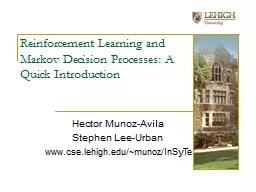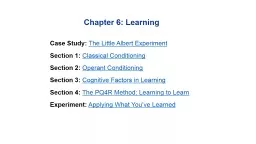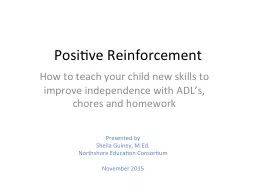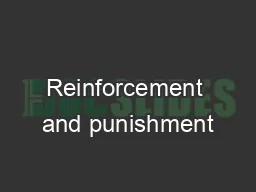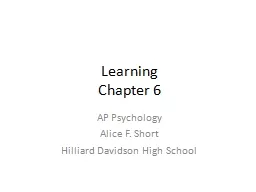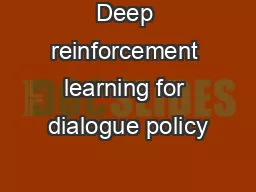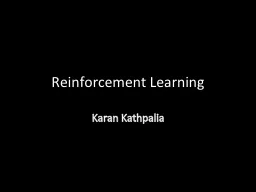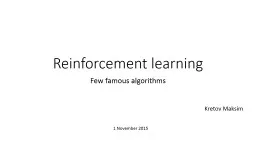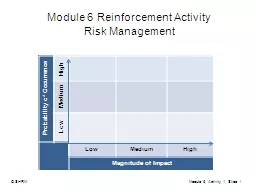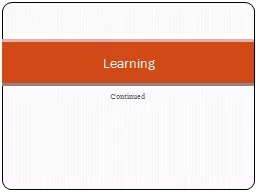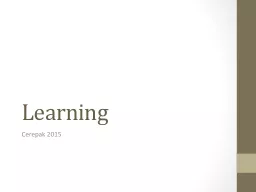PPT-Reinforcement Learning
Author : stefany-barnette | Published Date : 2020-02-01
Reinforcement Learning BY SHIVIKA SODHI INTRODUCTION Study How agents can learn what to do in the absence of labeled examples Ex In chess a supervised learning
Presentation Embed Code
Download Presentation
Download Presentation The PPT/PDF document "Reinforcement Learning" is the property of its rightful owner. Permission is granted to download and print the materials on this website for personal, non-commercial use only, and to display it on your personal computer provided you do not modify the materials and that you retain all copyright notices contained in the materials. By downloading content from our website, you accept the terms of this agreement.
Reinforcement Learning: Transcript
Reinforcement Learning BY SHIVIKA SODHI INTRODUCTION Study How agents can learn what to do in the absence of labeled examples Ex In chess a supervised learning agent needs to know about every correct move but that feedback is seldom available. Jared Christen. Tetris. Markov decision processes. Large state space. Long-term strategy without long-term knowledge. Background. Hand-coded algorithms can clear > 1,000,000 lines. Genetic algorithm by Roger . Hector Munoz-Avila. Stephen Lee-Urban. www.cse.lehigh.edu/~munoz/InSyTe. Outline. Introduction. Adaptive Game AI. Domination games in Unreal Tournament©. Reinforcement Learning. Adaptive Game AI with Reinforcement Learning. Case Study:. . The Little Albert Experiment. Section 1:. . Classical Conditioning. Section 2:. . Operant Conditioning. Section 3:. . Cognitive Factors in Learning. Section 4:. . The PQ4R Method: Learning to Learn. How to teach your child new skills to improve independence with ADL’s, chores and homework. Presented by . Sheila Guiney, M.Ed.. Northshore Education . Consortium. November 2015. Teaching your child new skills. mwahahahahaha. Reinforcement. Any object or event that strengthens or . increases. the frequency of a response that it follows.. Punishment. Is the delivery of an unpleasant consequence following a response which . Alice F. Short. Hilliard Davidson High School. Chapter Preview. Classical Conditioning. Operant Conditioning. Observational Learning. Factors That Affect Learning. Learning and Health and Wellness. Types of Learning. optimisation. Milica. Ga. š. i. ć. Dialogue Systems Group. Structure of spoken . dialogue systems. Language understanding. Language generation. semantics. a. ctions. 2. Speech recognition. Dialogue management. Overview. Introduction to Reinforcement Learning. Finite Markov Decision Processes. Temporal-Difference Learning (SARSA, Q-learning, Deep Q-Networks) . Policy Gradient Methods (Finite . D. ifference Policy Gradient, REINFORCE, Actor-Critic). Kretov. Maksim. 5. vision. 1 November 2015. Plan. Part A: Reminders. Key definitions of RL and MDP. Bellman equations. General structure of RL . tasks. Part B: Application to Atari . games. Q-learning. Risk Management. Probability. of Occurrence. High. Medium. Low. Low. Medium. High. Magnitude. of Impact. Module 6, Activity 1, Slide . 1. © SHRM. Module 6 Reinforcement Activity. Risk Management. The vice president of HR for a mid-sized bank has listed. With classical conditioning you can teach a dog to salivate, but you cannot teach it to sit up or roll over. Why?. Salivation is an involuntary reflex, while sitting up and rolling over are far more complex responses that we think of as voluntary. . Deep Reinforcement Learning Sanket Lokegaonkar Advanced Computer Vision (ECE 6554) Outline The Why? Gliding Over All : An Introduction Classical RL DQN-Era Playing Atari with Deep Reinforcement Learning [2013] A relatively permanent change in an organism’s behavior due to experience. Classical Conditioning. Operant Conditioning. Observational Learning. Classical Conditioning. Ivan Pavlov. Dogs trained to salivate (CR) to sound of bell (CS) . . The Little Albert Experiment. Section 1:. . Classical Conditioning. Section 2:. . Operant Conditioning. Section 3:. . Cognitive Factors in Learning. Section 4:. . The PQ4R Method: Learning to Learn.
Download Document
Here is the link to download the presentation.
"Reinforcement Learning"The content belongs to its owner. You may download and print it for personal use, without modification, and keep all copyright notices. By downloading, you agree to these terms.
Related Documents

